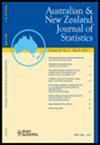Short-term forecasting with a computationally efficient nonparametric transfer function model
Abstract
In this paper a semi-parametric approach is developed to model non-linear relationships in time series data using polynomial splines. Polynomial splines require very little assumption about the functional form of the underlying relationship, so they are very flexible and can be used to model highly non-linear relationships. Polynomial splines are also computationally very efficient. The serial correlation in the data is accounted for by modelling the noise as an autoregressive integrated moving average (ARIMA) process, by doing so, the efficiency in nonparametric estimation is improved and correct inferences can be obtained. The explicit structure of the ARIMA model allows the correlation information to be used to improve forecasting performance. An algorithm is developed to automatically select and estimate the polynomial spline model and the ARIMA model through backfitting. This method is applied on a real-life data set to forecast hourly electricity usage. The non-linear effect of temperature on hourly electricity usage is allowed to be different at different hours of the day and days of the week. The forecasting performance of the developed method is evaluated in post-sample forecasting and compared with several well-accepted models. The results show the performance of the proposed model is comparable with a long short-term memory deep learning model.

 求助内容:
求助内容: 应助结果提醒方式:
应助结果提醒方式:


